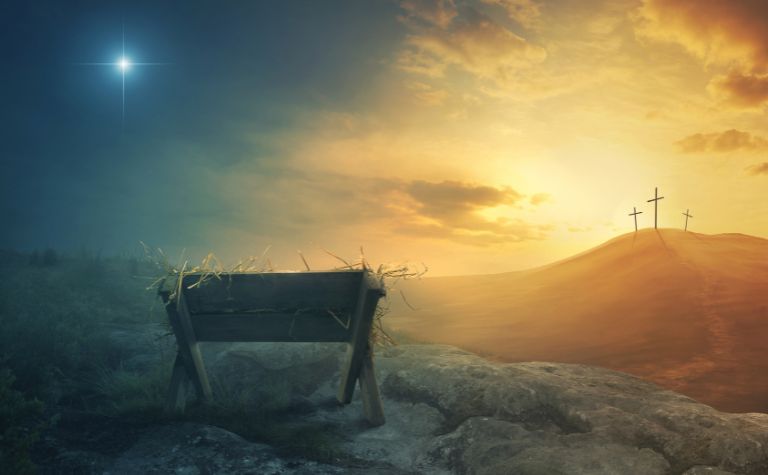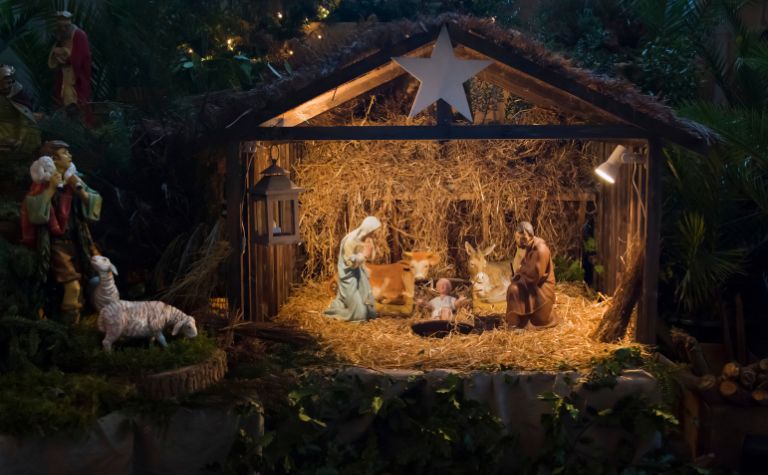The story of Jesus Christ’s birth is one of the most well-known in the Bible. It includes Mary and Joseph, beautiful angels, adoring shepherds, a guiding light in the sky, and a dangerous threat from a jealous politician. Yet the manger is one of the most iconic images of Jesus’ birth story.
The word “manger” refers to the place where Mary gave birth to Jesus. The Greek word describes an unsophisticated structure that may have been three-sided. Its purpose was to shelter animals, like oxen and donkeys, giving them a dry place to eat and sleep. People today might call it a “stall.”
What does the New Testament say about Jesus’ manger? What does the Greek word mean? Is Justin Martyr’s description of the manger accurate? Where does the Old Testament reference mangers? Keep reading to learn the answers to these questions and others.
Also see Why Was Jesus Born In a Manger? to learn more.

What does the New Testament say about Jesus’ manger?
The word “manger” appears four times in the New Testament. Luke is the only writer who uses the word, which he does three times in the second chapter of his Gospel and another time when he quotes Jesus.
The first time he refers to a manger, it describes Jesus’ birth. The second and third time it describes the shepherds’ visit. The fourth time is to quote Jesus.
- Luke 2:7, “And she gave birth to her firstborn son and wrapped him in swaddling cloths and laid him in a manger, because there was no place for them in the inn.”
- Luke 2:12, “And this will be a sign for you: you will find a baby wrapped in swaddling cloths and lying in a manger.”
- Luke 2:16, “And they went with haste and found Mary and Joseph, and the baby lying in a manger.”
The only occurrence of the word “manger” in the New Testament outside Jesus’ birth story is in Luke 13:15, “Then the Lord answered him, ‘You hypocrites! Does not each of you on the Sabbath untie his ox or his donkey from the manger and lead it away to water it?'” Jesus isn’t using the word in reference to his birth, but to make a point about the Sabbath.
Also see How Old Was Joseph When Jesus Was Born? to learn more.
Why was Jesus born in a manger?
At the time of Jesus’ birth, Joseph and Mary traveled to Bethlem to be counted for a census that Caesar Augustus decreed to occur (Luke 2:1-5). While they were there, the time came for Jesus to be born. The couple sought a room in an inn, but no vacancies were available for them (v. 6).
Mary and Joseph settled for an alternative dwelling nearby, which was a manger: “And she gave birth to her firstborn son and wrapped him in swaddling cloths and laid him in a manger, because there was no place for them in the inn” (v. 7).
The couple may not have had time to find a more sanitary place for Mary to give birth. Additionally, because they were poor, they may not have been able to afford one either.
Were there animals in the manger when Jesus was born?
Animals like cows and camels are a part of most nativity scenes today. But, is this an accurate depiction? While Luke 13:15 and a few verses in the Old Testament (see below) teach that mangers were for animals like oxen and donkeys, Luke doesn’t mention the presence of any animals.
However, that doesn’t mean that none were near. If Mary’s delivery occurred hastily, there may not have been time to move the animals to another place.
Also see How Old Was Mary When She Gave Birth to Jesus? to learn more.

What does Justin Martyr say about the manger?
Justin Martyr (so-name because he died for his faith) was one of the first Christians in the generation after the apostles, living from 100 to 165 A.D. He is known for defending the Christian faith against heretical and skeptical attacks.
In Justin’s well-known writing called Dialogue with Trypho, which scholars date to 155-160 A.D., he mentions that the location of the manger was in a cave in (or perhaps just outside of) Bethlehem. He writes:
“But when the child was born in Bethlehem, since Joseph could not find a lodging in that village, he took up his quarters in a certain cave near the village; and while they were there Mary brought forth the Christ and placed Him in a manger, and here the Magi who came from Arabia found Him” (Ch. 78). [1]
Some Bible scholars argue that Justin’s description of the manger being in a cave is credible for a few reasons. First, people at the time placed mangers in caverns hewn out of rocky hillsides because it protected animals from the elements. Second, Justin only lived 40 miles (about 77 kilometers) from Bethlehem, which suggests that he may have been familiar with the area.
Did the manger belong to the inn?
Another suggestion scholars make is that the manger was attached to the inn or its courtyard. An adjacent dwelling place for animals was a typical setup in the first century because visitors needed a place to keep the ones they traveled with, like a donkey, when they lodged in the inn.
Also see How Many Wise Men Visited Jesus? to learn more.

Mangers in the Old Testament
In the Old Testament, the books of Job, Proverbs, and Isaiah mention a manger-like structure for animals. English Bibles often render the word “manger,” stall,” or something similar. Job 39:9 is an example.
| Translation | Job 39:9 |
|---|---|
| ESV | “Is the wild ox willing to serve you? Will he spend the night at your manger?” |
| KJV | “Will the unicorn be willing to serve thee, or abide by thy crib?” |
| NASB | “Will the wild ox consent to serve you, Or will he spend the night at your manger?” |
| NIV | “Will the wild ox consent to serve you? Will it stay by your manger at night?” |
| NLT | “Will the wild ox consent to being tamed? Will it spend the night in your stall?” |
The Hebrew word translated “manger” is ebus. It describes a crib for an animal where they would eat and sleep. Oxen and donkeys are associated with mangers in the Old Testament, but that doesn’t mean other animals didn’t use them. But animals like sheep and pigs were probably in pens.
- Proverbs 14:4, “Where there are no oxen, the manger is clean, but abundant crops come by the strength of the ox.”
- Isaiah 1:3, “The ox knows its owner, and the donkey its master’s crib, but Israel does not know, my people do not understand.”
“Down through the years God’s love has shined through misery, tears, and sin like a shaft of sunlight on a dark day. We see God’s love in His revelation, in His mercy, in His patience, and in His redemption. We see the love of God as the infinite One becomes an infant in Bethlehem’s manger. We see it in His life and ministry. And most of all we see it as He hangs on the cross, dying for our sins.” – George Sweeting [2]
Also see Was Jesus Born In April? to learn more.
References:
[1] Source
[2] Who Said That? by George Sweeting. p. 211.
Related Articles
The visit of the wise men (also called magi) to Jesus is one of the most iconic moments in the early chapters of the Gospel of Matthew. Though they weren't huddled in the manger with the holy family,...
The public ministry of Jesus of Nazareth lasted approximately three years. Matthew, Mark, Luke, and John describe Jesus' miraculous birth and a few stories from his early life like his family's...
